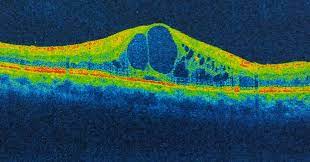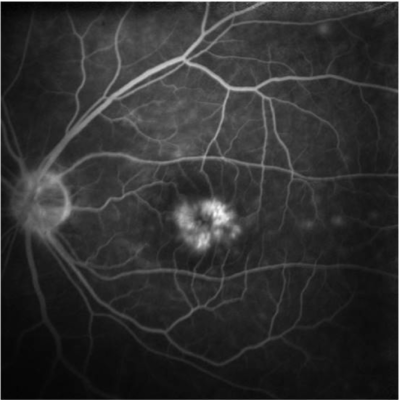 The thin light-sensitive tissue lining the back of the eye is known as the retina. Located in the centermost region of the retina is the macula. The macula is responsible for your central pinpoint vision. A high concentration of cells known as photoreceptors is located within the macula. These cells are responsible for relaying images to the brain to produce the outside world that you see. Maintaining a healthy macula is crucial for everyday activities such as recognizing faces, driving, and reading.
The thin light-sensitive tissue lining the back of the eye is known as the retina. Located in the centermost region of the retina is the macula. The macula is responsible for your central pinpoint vision. A high concentration of cells known as photoreceptors is located within the macula. These cells are responsible for relaying images to the brain to produce the outside world that you see. Maintaining a healthy macula is crucial for everyday activities such as recognizing faces, driving, and reading.
Sometimes, the macula becomes swollen with fluid. As with any other tissue in the body, when the macula swells it is known as edema. Swelling that occurs in the macula is often characterized by cyst-like patterns. This condition is known as cystoid macular edema.
What is Cystoid Macular Edema (CME)?
Cystoid macular edema (CME) is a painless condition that affects the central portion of the back of the retina, the macula. Cystoid macular edema is caused by leakage of fluid into the macula. This fluid often represents cyst-like formations.
What Causes Cystoid Macular Edema?
Pinpointing the direct cause of cystoid macular edema is difficult. Researchers, however, believe that you are more likely to develop cystoid macular edema if you have:
- Undergone eye surgery such as cataract surgery or retinal surgery
- Diabetic retinopathy – growth of abnormal blood vessels in the retina caused by diabetes
- Age-related macular degeneration (AMD)
- Retinal vein occlusion – blockage of the veins in the retina
- Injury to the eye
- Side effects to specific medications
- Inflammatory conditions such as uveitis and sarcoidosis

-
- Difficulty reading
- Distortion of colors
- Wavy or blurred central vision – straight lines may appear wavy or non-existent
- Increased light sensitivity.
Without intervention, profound vision loss can occur.
Can CME be Cured?
If cystoid macular edema is diagnosed early, effective treatment methods can begin to better preserve your vision. Although there is no definitive cure for cystoid macular edema, your ophthalmologist will explore various treatment options to manage your condition. Determining the underlying cause of your cystoid macular edema is crucial in developing the appropriate treatment plan. Treatment for CME is dependent on what is causing it. These treatment approaches may include:
- Steroid Medication – Edema that is caused by inflammation, such as uveitis, may be treated through the use of steroid medication. Initially, your ophthalmologist may prescribe you a course of steroid drops or oral medication. If this method shows little progression, steroid medication can be injected directly into the eye. Typically, the need for continued steroid use decreases over time.
- Non-steroid Medication – Patients who develop cystoid macular edema after cataract surgery may benefit from the use of non-steroidal anti-inflammatory medications (NSAIDs). The benefit of NSAIDs is that they can typically fight inflammation without the negative side effects of steroid drops. Your ophthalmologist may elect to prescribe you NSAID drops for a few months to reduce inflammation in the eye and prevent it from recurring.
- Injections – intravitreal eye injections of anti-VEGF drugs aid in the reduction of growth of abnormal vessels in the retina. The growth of abnormal blood vessels causes leaking in the retina leading to edema. Anti-VEGF injections slow or prevent damage from abnormal blood vessel growth. Consequently, this slows the progression of vision loss. Those who are showing a positive response to intravitreal injections may begin to spread out their injection interval. This allows your ophthalmologist to potentially wean you off the medication or allow you to receive injections only a few times a year.
- Laser Therapy – Focal laser therapy may be recommended to patients who are showing minimal progression with other treatment interventions. This in-office procedure is performed on one eye at a time. Your ophthalmologist will apply many small laser pulses to the areas of leakage around the macula. This will cause the leaking blood vessels to seal off and stabilize your vision.
- Vitrectomy Surgery – In rare cases, cystoid macular edema may be caused by the gel-like fluid in the eye pulling on the macula. In the event this occurs, your ophthalmologist may recommend you undergo a vitrectomy. This procedure entails removing the vitreous fluid in the eye to allow the macula to relax back to its normal state. During this procedure, your surgeon may use a specialized instrument to remove any scar tissue causing traction on the retina.
Depending on the underlying cause of the cystoid macular edema a combination of these treatment therapies may be useful to alleviate any swelling in the eye. Resolving macular edema can take several months. Following the strict treatment plan your ophthalmologist provides is crucial in preserving your vision. Additionally, once the swelling in the eye has resolved, it is important to continue regular eye exams and imaging to ensure the swelling has not returned.
What If I Do Nothing?
The more widespread and severe the swelling in the macula becomes the more likely you are to notice significant visual symptoms. If cystoid macular edema is left untreated, chronic edema can lead to irreversible damage to the macula. This will result in permanent vision loss. It is crucial to consult your ophthalmologist if you are experiencing any symptoms related to cystoid macular edema.


